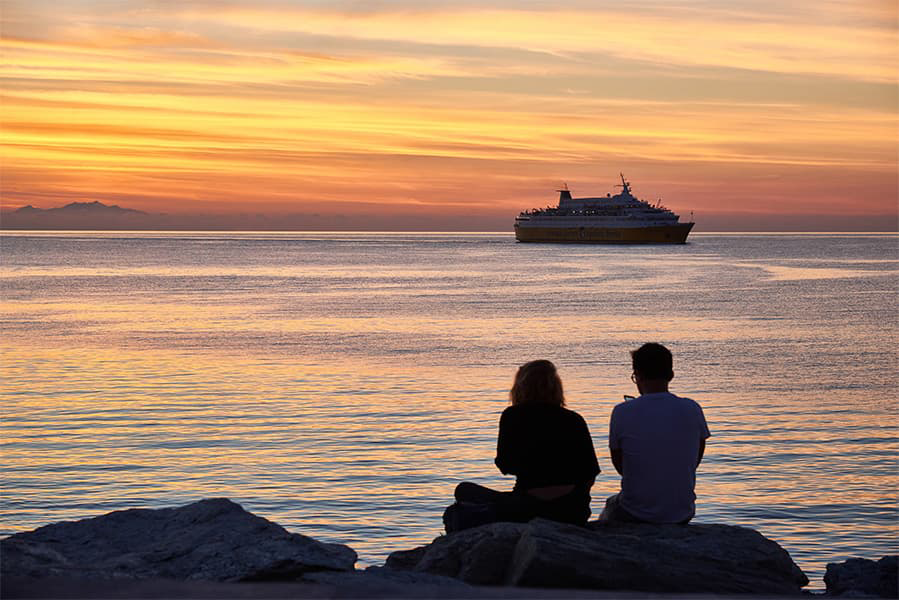Yeosu – Jeju
Ferries to South Korea
Yeosu – Jeju
Ferries to South Korea

There are around 5 weekly sailings from Yeosu to Jeju. The Yeosu Jeju ferry is operated by
Ferries from Yeosu to Jeju typically depart from Yeosu at around 00:20. The average sailing time of a Jeju Yeosu ferry is approximately 6h 40m.
Ferry prices for Yeosu Jeju ferries typically range between €41* and €165*. The average price is around €121*. The cheapest ferry prices from Yeosu to Jeju start from €35*. The average price for a foot passenger is €121*.
Pricing will vary by season and depend on the number of passengers, vehicle type and sailing time.
The distance between Yeosu to Jeju is approximately 98.8 miles (159.0km), or 85.9 nautical miles.
No ferry operators currently provide a car ferry between Yeosu and Jeju
Yes, foot passengers can travel on ferries from Yeosu to Jeju with Hanil Express.
More routes than anyone else.

Compare fares, times & routes in one place.
Change plans easily with flexi tickets.

Book e-tickets & manage trips in-app.
Live ship tracking & real-time updates.

Top-rated customer support when you need it.
| Yeosu - Jeju Route summary | ||
|---|---|---|
| Departure Country | South Korea | |
| Destination Country | South Korea | |
| No. of Operators | 1 | |
| Operators | Hanil Express | |
| Average Price | 121 €* | |
| Average Weekly Sailings | 5 | |
| Average Sailing Duration | 6h 40m | |
| First Ferry | 00:20 | |
| Distance | 85 nautical miles | |
* Prices subject to change, pricing is taken from last 30 days, last updated 2024-09-04.
Found across the Sea of Japan that stretches along the southern coast of South Korea is the volcanic island of Jeju. This oval shaped landmass, known as the “Island of Gods” due to legends that claim the islanders are the distant descendants of demi-Gods, is blessed with year-round warmth, beautiful white sand beaches, and a thriving, emerald-green landscape dominated by the cloud-covered peak of Mount Hallasan. Not only is the sub-tropical island a popular destination for love-struck newly-weds, it is also a treasure trove of natural wonders. The Manjanggul Lava-tube, found within a cave on the north coast, is an astounding 20-metre high column of solidified magma that is listed as a UNESCO World Natural Heritage site. Another spectacle is the Cheonjiyeon Waterfall (translated literally as “sky connected with land”). Here spring water, pooled atop a rocky outcrop, cascades into an artificial pond illuminated at night by a series of underwater lamps. The port of Jeju is found in the sprawl of Jeju City on the island’s northern coast. This facility, located at the edge of the Geonip-dong district in the very heart of the city, is relatively small; it consisting of little more than a few piers that jut in a saw-tooth fashion from the shoreline and into the sea. The ferry terminal is located on one of the largest and westernmost of these piers. It is home to a handful of passenger amenities including a compact car-park, an indoor waiting room, toilet facilities, a tourist information booth, and a small café selling food and drink. Due to the port’s location near the city centre, it is well supported by a number of transport links. Though it can be easy to get lost in the maze of streets that cut between the modern apartment blocks and skyscrapers, a few main road routes lead directly from the downtown districts to the rolling, rural outskirts. An extensive system of inner city buses regularly whisks passengers through Jeju City from stops near the harbour; while another, more expansive service offers routes into the surrounding area - including to the nearby international airport. A number of routes currently leave from the port in Jeju a few times throughout the week. Services hosted by Hanil Express sail north out from the mouth of the harbour to the port of Chuja island and the mainland town of Wando on South Korea’s shattered southern coast, both a short distance across the ultramarine waves of the Sea of Japan.